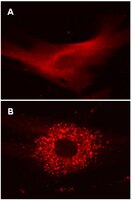17-10143 Sigma-AldrichLentiBrite™ RFP-LC3 Lentiviral Biosensor
お勧めの製品
概要
| Replacement Information |
|---|
主要スペック表
| Key Applications | Detection Methods |
|---|---|
| TFX, IF, ICC | Fluorescent |
| Description | |
|---|---|
| Catalogue Number | 17-10143 |
| Trade Name |
|
| Description | LentiBrite™ RFP-LC3 Lentiviral Biosensor |
| Overview | Also available: LentiBrite GFP-p62 Lentiviral Biosensor! Click Here Also available: LentiBrite RFP-p62 Lentiviral Biosensor! Click Here Read our application note in Nature Methods! http://www.nature.com/app_notes/nmeth/2012/121007/pdf/an8620.pdf (Click Here!) Learn more about the advantages of our LentiBrite Lentiviral Biosensors! Click Here Biosensors can be used to detect the presence/absence of a particular protein as well as the subcellular location of that protein within the live state of a cell. Fluorescent tags are often desired as a means to visualize the protein of interest within a cell by either fluorescent microscopy or time-lapse video capture. Visualizing live cells without disruption allows researchers to observe cellular conditions in real time. Lentiviral vector systems are a popular research tool used to introduce gene products into cells. Lentiviral transfection has advantages over non-viral methods such as chemical-based transfection including higher-efficiency transfection of dividing and non-dividing cells, long-term stable expression of the transgene, and low immunogenicity. EMD Millipore is introducing LentiBrite™ Lentiviral Biosensors, a new suite of pre-packaged lentiviral particles encoding important and foundational proteins of autophagy, apoptosis, and cell structure for visualization under different cell/disease states in live cell and in vitro analysis.
EMD Millipore’s LentiBrite™ RFP-LC3 lentiviral particles provide bright fluorescence and precise localization to enable live cell analysis of autophagy in difficult-to-transfect cell types. |
| Alternate Names |
|
| Background Information | Autophagy, a degradative pathway that provides recycled nutrients to cells under stress, plays both protective and deleterious roles in many diseases, including cancer, neurodegeneration, and infections. Members of the LC3 family play a key role in the maturation of the autophagosome, the central organelle of autophagy. LC3 precursors, diffusely distributed in the cytosol, are proteolytically processed to form LC3-I. Upon initiation of autophagy, the C-terminal glycine is converted to LC3-II by addition of a phosphatidylethanolamine by Atg5-Atg12. LC3-II translocates rapidly to nascent autophagosomes in a punctate distribution. DNA constructs encoding fluorescent proteins fused to LC3 are widely employed for introduction into cells for monitoring autophagosome formation by fluorescence microscopy. EMD Millipore’s LentiBrite™ RFP-LC3 lentiviral particles provide bright fluorescence and precise localization to enable live cell analysis of autophagy in difficult-to-transfect cell types. |
| References |
|---|
| Product Information | |
|---|---|
| Components |
|
| Detection method | Fluorescent |
| Quality Level | MQ100 |
| Biological Information | |
|---|---|
| Gene Symbol |
|
| Purification Method | PEG precipitation |
| UniProt Number | |
| Physicochemical Information |
|---|
| Dimensions |
|---|
| Materials Information |
|---|
| Toxicological Information |
|---|
| Safety Information according to GHS |
|---|
| Safety Information |
|---|
| Product Usage Statements | |
|---|---|
| Quality Assurance | Evaluated by transduction of HT-1080 cells at MOI values of 20 and 40. Fluorescent imaging performed for assessment of target localization and transduction efficiency. |
| Usage Statement |
|
| Packaging Information | |
|---|---|
| Material Size | 1 vial (minimum of 3 x 10E8 IFU/mL) |
| Transport Information |
|---|
| Supplemental Information |
|---|
| Specifications |
|---|
| Global Trade Item Number | |
|---|---|
| カタログ番号 | GTIN |
| 17-10143 | 04053252639982 |
Documentation
LentiBrite™ RFP-LC3 Lentiviral Biosensor (M)SDS
| タイトル |
|---|
LentiBrite™ RFP-LC3 Lentiviral Biosensor 試験成績書(CoA)
カタログ
| タイトル |
|---|
| Advancing cancer research: From hallmarks & biomarkers to tumor microenvironment progression |
| Hallmarks of Aging |
技術情報
| タイトル |
|---|
| LentiBrite™ Lentiviral Biosensors for Fluorescent Cellular Imaging: Analysis of Autophagosome Formation |
Posters
| タイトル |
|---|
| Autophagy Signaling |











